
Internal medicine is a big rotation, generally 2-3 months long. It covers so much material, essentially the bulk of Step 2 CK, and is the foundation for many specialties. This post will serve as a guide for how to study for the internal medicine clerkship and really excel on the floors.
Typical Schedule
This varies immensely at each hospital. At my hospital, we had 2 months of inpatient and one month of outpatient. I did one month on a general inpatient floor, 2 weeks of inpatient hematology/oncology, 2 weeks of GI consults, and a month of multidisciplinary outpatient (1 week of GI, cardiology, pulmonology, and endocrine). On a general inpatient month, sign out is usually around 7am. Rounds are around 9am after morning report, ending just before noon conference. Afternoons are generally for following up with patients and labs/radiology/pathology, teaching, calling other providers, and arranging discharges. Outpatient rotations are more of an 8-5 schedule. Inpatient consult services tend to start seeing patients at 8am, although there may be 7am conferences.
Your Expectations
As always, ask your expectations at the beginning of the rotation. Periodically, ask for feedback, especially if you are not given feedback in real time.
Inpatient Medicine
On a general inpatient medicine rotation, expect to be at the hospital early to see a new patient admitted overnight, potentially write the admission H&P, and follow up with your old patients. Talk to the overnight nurses to see how your patients did overnight. The nurses are extremely helpful and wonderful advocates for their patients. They help us so much with their experience, as we are still learning. Remember, the history is the most important part and should be very detailed. Do not always trust the admission notes. Verify the information for yourself, ask any questions that may have been missed, and verify the patient’s home medication list as errors here are common. You may need to call the patient’s pharmacy.
Trend your patient’s labs and identify whether your patient may need a change in management, such as medication alterations or a test/procedure. Ideally, you will have completed your notes and be ready to present your patients on rounds. Prepare to interpret your patient’s labs, radiology, and EKGs in front of the team on rounds. Don’t be intimidated. It is okay to make a mistake and it helps everyone to go through a chest x-ray or EKG systematically.
Outpatient Medicine
Your outpatient medicine rotation may look very similar to your family medicine rotation or be a subspecialty clinic. My placement was subspecialty. I already knew I liked GI, but it was so great to experience some of the other subspecialties. I loved cystic fibrosis clinic in pulmonology and transgender clinic in endocrinology. For cystic fibrosis clinic, it was amazing to see how well some of these patients were doing on triple therapy and how there are a variety of mutations and severity of presentations.
For example, we had one patient who was well into her 60s and a smoker. She was doing okay. Then, we had young patients who never smoked a day in their lives and already had double lung transplants. I will never forget this one patient who had struggled with severe cystic fibrosis for years until he was placed on a triple therapy trial. He now has no cough, no mucus production, has gained weight (and has to watch his diet), and he has to save for retirement. He never thought he would reach retirement age. Modern medicine is so incredible.
As in other outpatient clinics, you will likely see the patients on your own, present to the resident/fellow/attending, go back and see the patient with your supervisor, and write a note. Do your best to keep an open mind even if you do not agree with your patient’s beliefs, be kind, encourage smoking cessation, and listen. Sit down, look at the patient, and listen. Hear their fears, concerns, and questions. Look for areas the medical team can intervene. Ask about the patient’s life, family, work, and stressors. If you do not get to know the patient as a person, you will not comprehensively treat their condition.
What You Need
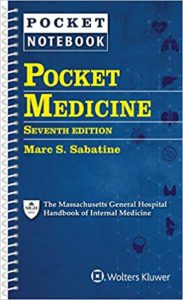
Pocket Medicine – This little book fits right in the tiny pocket of your coat and has so many things you need to know, especially for inpatient medicine. It’s a great guide to reference during rounds, especially if you do not want to pull out your phone.
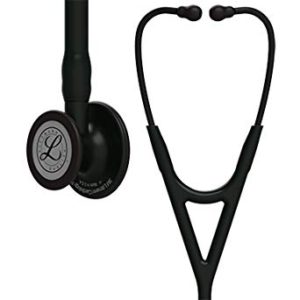
Stethoscope – I have this stethoscope (Littmann Cardiology IV) in burgundy and love it. This is the most popular stethoscope among medical students.
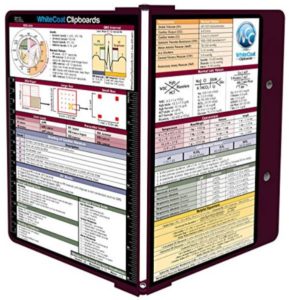
Medical Clipboard – I absolutely love this clipboard. It is perfect for keeping notes and taking histories, and it’s HIPAA compliant. Plus, it has lots of essential facts. Even better, it folds right up and fits in your white coat! (Make sure you buy the medical version, not the nursing version).
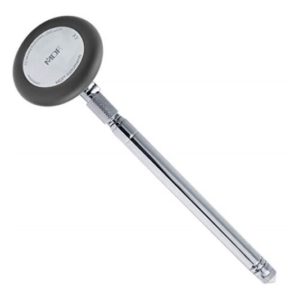
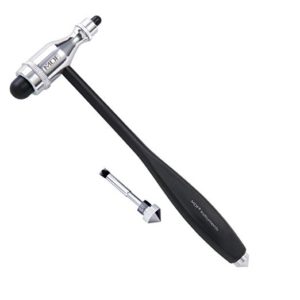
These two reflex hammers are very popular and easy to get reflexes on. I have the circular telescoping one, but the hammer one is also great! I was terrible at getting reflexes on the cheaper reflex hammers, and now it’s a breeze using these hammers.

Pen Light – so important and I love the rose gold!
How to Study for the Internal Medicine Clerkship
This is another one of the harder shelf examinations. Studying for the internal medicine shelf is very much like studying for Step 2 CK. Your best friends will be OnlineMedEd and UWorld. Start tackling both early into the rotation, especially since UWorld has over 1300 medicine questions. I did not nearly finish them. I did all of the OnlineMedEd videos for internal medicine, used some Master the Boards, Step Up to Medicine, and some of the Internal Medicine Essentials text and questions. As always, the shelf is a smaller part of your grade. It’s important to do well on the floors and in your evaluations. This will all prepare your for the OSCE as well.
Always take an NBME practice test if you can. Our school gave us one free voucher for every clerkship (they cost $20). They tended to be pretty accurate in terms of predicting scores and some of the questions were very similar to the actual shelf. Aim to take one mid-way through the rotation to make sure you are passing.
Resources
In addition to UWorld and OnlineMedEd, there are multiple other resources that are invaluable on this rotation.
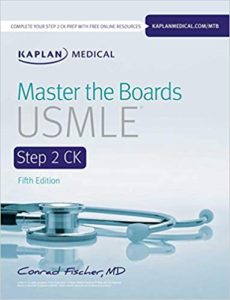
Kaplan Master the Boards – For all your rotations, you should annotate the UWorld explanations into a central text. For Step 2CK, I preferred Kaplan’s Master the Boards to First Aid for Step 2 CK.
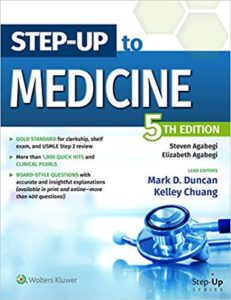
Step Up to Medicine – This is one of the most popular books medical students use to study for the internal medicine shelf. It is colorful, full of high yield information, and reads like a story.
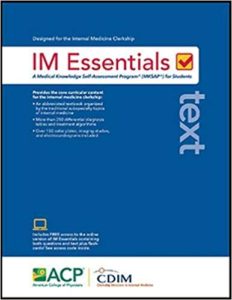
IM Essential Text – This is what clerkship directors want you to know. Sometimes your school library will have this book for free, and it’s actually very helpful to read the sections.
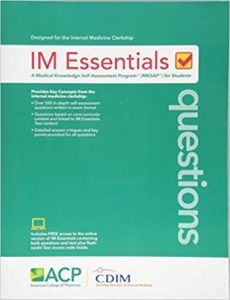
IM Essentials Question Book – This is a companion to the IM Essentials Text. If you buy this book, it comes with an online version of the text. This hits all the important points that the clerkship directors want students to know.
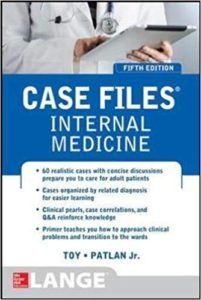
Case Files for Internal Medicine – Case Files is always a popular series for shelf studying and OSCE preparation because of how easy it is to pick up between patients.
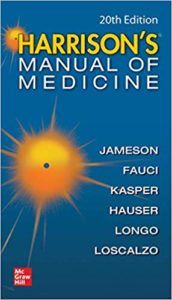
Harrison's – This is the “bible” for internal medicine. If you like reading everything you need to know about a topic and do well with long chapters, this is your book.
How did you study for your internal medicine clerkship?
Disclaimer: There are affiliate links in this post to support this site and keep it ad free. There are no additional costs to you.

Leave a Reply